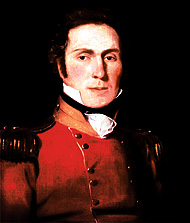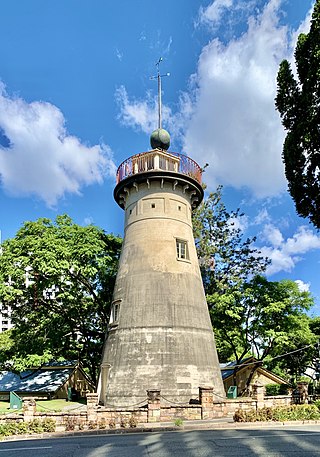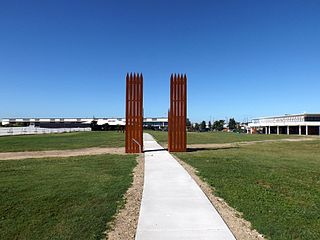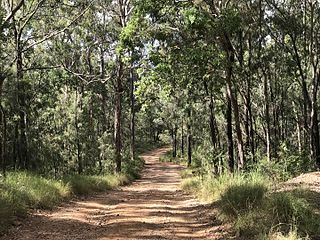
Owen Gorman was a British Army officer and commandant of the Moreton Bay penal colony. [1]

Owen Gorman was a British Army officer and commandant of the Moreton Bay penal colony. [1]
Gorman was born on 25 July 1799 at Clogham, King's County, Ireland. [1]
Gorman enlisted in the 58th Foot Regiment as a private soldier on 25 August 1817. He rose through the ranks and become Lieutenant on 1 June 1833. [1] Gorman served as the last commandant of the Moreton Bay penal colony from July 1839 to May 1842 and was responsible for transitioning Brisbane from a penal colony to free settlement. In 1843 after the closure of the penal colony, Gorman was appointed Superintendent of the Iron Gangs at the Towrang Convict Stockade near Goulburn in New South Wales. [1]
In 1840, the penal colony at Moreton Bay was being prepared to be turned into a free settlement (which ultimately became the city of Brisbane). As there was settlement already occurring west of Moreton Bay on the Darling Downs, Gorman needed to find a wagon route between the two locations, but the obstacle was the mountains of the Great Dividing Range. There was a route already known at Cunninghams Gap but it was not able to be used by a wagon. A convict John Sterry Baker had escaped from the penal colony in 1826 and had lived among the Goomburra Aboriginal people in the Lockyer Valley area and walked with them on a track to the top of the range. Having returned to the penal colony in 1840, Baker told Gorman of the track up the range and modified an Irish jaunting car to test as a wagon on the route. Together Gorman and Baker ascended the range with their wagon on 17 October 1840 arriving at Eton Vale. Despite the fact that Gorman did not discover the route, it nonetheless became known as Gorman's Gap Road. The route which runs between Upper Flagstone in the west and Flagstone Creek in the east was marked by blazing a line of trees. It became the first gazetted road in Queensland. Today, the road no longer officially exists and is overgrown but can still be followed. There are three monuments along the route, one at each end and the other along the route at Camel's Hump where Gorman took his compass bearing. [2] [3] [4]
Gorman resigned his commission in the army in 1845. [1] About 1855 he moved to Armidale. [5]
Gorman died on 6 October 1862 in Armidale. [5]

Captain Patrick Logan was the commandant of the Moreton Bay Penal Settlement from 1826 until his death in 1830 at the hands of Aboriginal Australians who objected to him entering their lands. As he had been hated by convicts, there were rumours that escaped convicts living in the bush had attacked him, but there is no evidence of this.

Brisbane's recorded history dates from 1799, when Matthew Flinders explored Moreton Bay on an expedition from Port Jackson, although the region had long been occupied by the Yugara and Turrbal aboriginal tribes. The town was conceived initially as a penal colony for British convicts sent from Sydney. Its suitability for fishing, farming, timbering, and other occupations, however, caused it to be opened to free settlement in 1838. The town became a municipality in 1859 and a consolidated metropolitan area in 1924. Brisbane encountered major flooding disasters in 1893, 1974, 2011 and 2022. Significant numbers of US troops were stationed in Brisbane during World War II. The city hosted the 1982 Commonwealth Games, World Expo 88, and the 2014 G20 Brisbane summit

The Old Windmill is a heritage-listed tower mill in Observatory Park adjacent to Wickham Park at 226 Wickham Terrace, Spring Hill, City of Brisbane, Queensland, Australia. It was built in the 1820s by convict labour in the Moreton Bay penal settlement and is the oldest surviving building in Queensland. It is also known as Brisbane Observatory and Windmill Tower. It was added to the Queensland Heritage Register on 21 October 1992. Today it is the centrepiece of Observatory Park and a lookout over parts of the Brisbane CBD.
Lieutenant George Gravatt (1815–1843) was an officer in the British Army. In May 1839, he succeeded Sir Sydney Cotton as commander of the Moreton Bay penal settlement in what is now Brisbane, Queensland, Australia. He held the position for three months.

Logan Village is a semi-rural town and locality in the City of Logan, Queensland, Australia. In the 2016 census, the locality of Logan Village had a population of 4,417 people. Logan Village was once known as the head of the navigable Logan River. Its importance as a town grew again when the railway arrived.

Old Cleveland Road is a major road in Brisbane, Queensland. It runs 19.3 kilometres (12.0 mi) from Stones Corner to Capalaba in Brisbane, with most of the route signed as State Route 22. Sections of the road are also part of State Routes 30, 54, and 55. The road is the main route from inner Brisbane to Capalaba and Cleveland since New Cleveland Road only links Tingalpa with Capalaba.

Commissariat Store is a heritage-listed storehouse at 115–127 William Street, Brisbane City, City of Brisbane, Queensland, Australia. It is bordered by William Street, Queen's Wharf Road and the Brisbane River, and is the birthplace of Queensland. It was designed by William John Dumaresq and built from 1828 to 1913 by convict labour under the direction of Captain Logan as a permanent Commissariat Store for the Moreton Bay penal settlement. It is also known as Government Stores, State Stores Building, and Colonial Store. It was added to the Queensland Heritage Register on 21 October 1992.

Eagle Farm Women's Prison and Factory Site is a heritage-listed archaeological site at 116 Lamington Avenue, Eagle Farm, City of Brisbane, Queensland, Australia. It operated between 1829 and 1839 as part of the Moreton Bay penal settlement. It is on the site now part of the Australia TradeCoast, previously the Eagle Farm Airport. It was added to the Queensland Heritage Register on 7 February 2005.
Flagstone Creek is a rural locality in the Lockyer Valley Region, Queensland, Australia. In the 2016 census, Flagstone Creek had a population of 220 people.
Upper Flagstone is a rural locality in the Lockyer Valley Region, Queensland, Australia. In the 2016 census Upper Flagstone had a population of 171 people.

The Early Streets of Brisbane is a heritage-listed archaeological site at sections of Albert Street, George Street, William Street, North Quay, and Queen's Wharf Road in Brisbane City, City of Brisbane, Queensland, Australia. It was built from 1825 onwards. It was added to the Queensland Heritage Register on 16 July 2010.

The Moreton Bay Penal Settlement operated from 1825 to 1842. It became the city of Brisbane, Queensland, Australia.

The First Brisbane Burial Ground is a heritage-listed archaeological site at Skew Street, Brisbane City, City of Brisbane, Queensland, Australia. It is also known as Skew Street Cemetery. It was established in 1825 as part of the Moreton Bay penal settlement. It was added to the Queensland Heritage Register on 16 July 2010.

Dunwich Public Reserve is a heritage-listed archaeological site at Junner Street, Dunwich, North Stradbroke Island in the City of Redland, Queensland, Australia. It was built from 1827 to 1828. It is also known as Privy Pit, Convict Barracks, and Convict Store within the Moreton Bay penal settlement. It was added to the Queensland Heritage Register on 25 February 2000.

Henry Miller (1785–1866) was the first commandant of the Moreton Bay penal colony in Queensland, Australia.

Spicers Gap Road is a heritage-listed road at Spicers Gap Road Conservation Park, Tregony, Southern Downs Region, Queensland, Australia. It was built from 1859 to 1865. It is also known as Spicers Gap Road Conservation Park and Spicers Peak Road. It was added to the Queensland Heritage Register on 23 July 1999.
Hannah Rigby was an Australian convict who was notable for serving three separate sentences of transportation. By remaining in Brisbane when the penal settlement closed in 1839, she became one of the first permanent settlers in what is now Queensland.
The following is a timeline of the history of the city of Brisbane, Queensland, Australia.

Queensland is the north-eastern state of Australia and has land borders with three other Australian states and territories: New South Wales, South Australia and Northern Territory. To the north of Queensland is the Torres Strait separating the Australian mainland from Papua New Guinea. To the east of Queensland is the Coral Sea, part of the Pacific Ocean. There are many islands off the Queensland coast which form part of the state of Queensland.
James Warner (1814–1891) was a pioneer surveyor in Queensland, Australia. Arriving at Moreton Bay penal colony in 1838, he was one of three surveyors who surveyed the area now Brisbane and its surrounding areas. He worked for 50 years in the Survey Office of Queensland, surveying and naming many towns and other features.